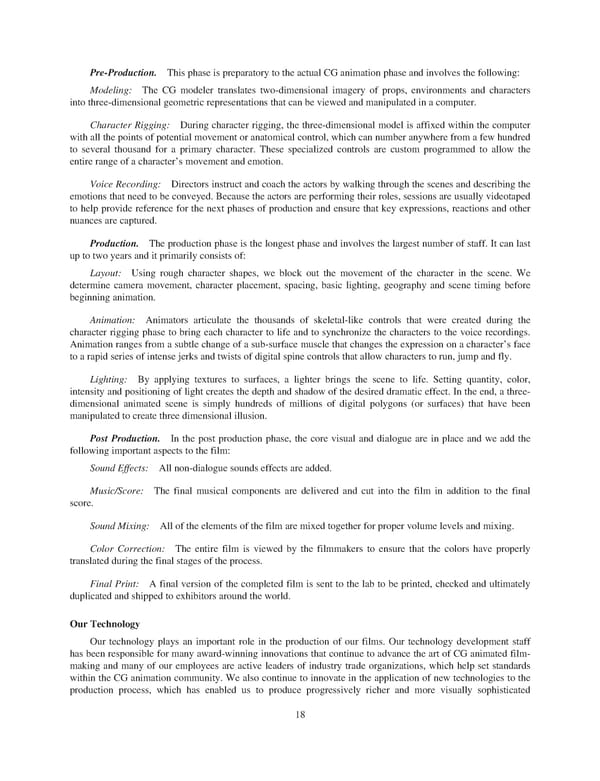Pre-Production. This phase is preparatory to the actual CG animation phase and involves the following: Modeling: The CG modeler translates two-dimensional imagery of props, environments and characters into three-dimensional geometric representations that can be viewed and manipulated in a computer. Character Rigging: During character rigging, the three-dimensional model is affixed within the computer with all the points of potential movement or anatomical control, which can number anywhere from a few hundred to several thousand for a primary character. These specialized controls are custom programmed to allow the entire range of a character’s movement and emotion. Voice Recording: Directors instruct and coach the actors by walking through the scenes and describing the emotions that need to be conveyed. Because the actors are performing their roles, sessions are usually videotaped to help provide reference for the next phases of production and ensure that key expressions, reactions and other nuances are captured. Production. The production phase is the longest phase and involves the largest number of staff. It can last up to two years and it primarily consists of: Layout: Using rough character shapes, we block out the movement of the character in the scene. We determine camera movement, character placement, spacing, basic lighting, geography and scene timing before beginning animation. Animation: Animators articulate the thousands of skeletal-like controls that were created during the character rigging phase to bring each character to life and to synchronize the characters to the voice recordings. Animation ranges from a subtle change of a sub-surface muscle that changes the expression on a character’s face to a rapid series of intense jerks and twists of digital spine controls that allow characters to run, jump and fly. Lighting: By applying textures to surfaces, a lighter brings the scene to life. Setting quantity, color, intensity and positioning of light creates the depth and shadow of the desired dramatic effect. In the end, a three- dimensional animated scene is simply hundreds of millions of digital polygons (or surfaces) that have been manipulated to create three dimensional illusion. Post Production. In the post production phase, the core visual and dialogue are in place and we add the following important aspects to the film: Sound Effects: All non-dialogue sounds effects are added. Music/Score: The final musical components are delivered and cut into the film in addition to the final score. Sound Mixing: All of the elements of the film are mixed together for proper volume levels and mixing. Color Correction: The entire film is viewed by the filmmakers to ensure that the colors have properly translated during the final stages of the process. Final Print: Afinal version of the completed film is sent to the lab to be printed, checked and ultimately duplicated and shipped to exhibitors around the world. OurTechnology Our technology plays an important role in the production of our films. Our technology development staff has been responsible for many award-winning innovations that continue to advance the art of CG animated film- making and many of our employees are active leaders of industry trade organizations, which help set standards within the CG animation community. We also continue to innovate in the application of new technologies to the production process, which has enabled us to produce progressively richer and more visually sophisticated 18
 DreamWorks Annual Report Page 23 Page 25
DreamWorks Annual Report Page 23 Page 25